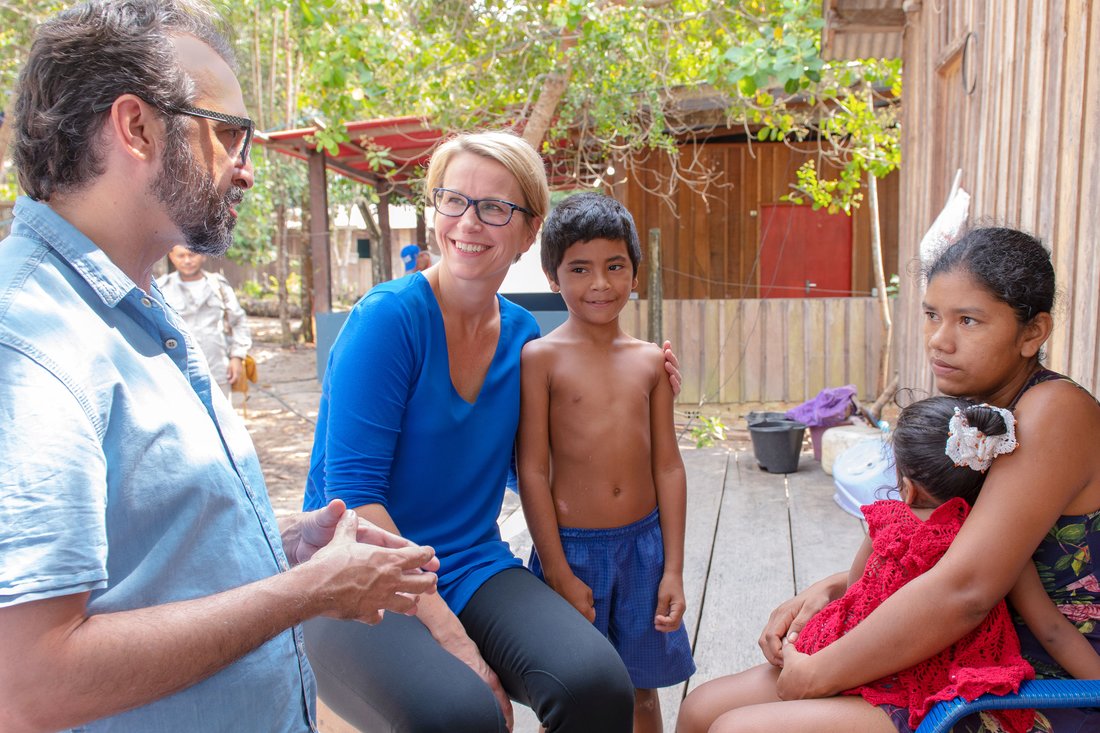這家大藥企的復興,依靠的是一個女人開出的猛藥

|
在退葛事件發生之時,艾瑪·沃姆斯利才剛剛上任葛蘭素史克首席執行官6周的時間,而葛蘭素史克是一家年營收額達389億美元的英國制藥公司。 退葛事件并非像英國脫歐這類地緣政治事件那樣有著世界影響力,但它對葛蘭素史克來說不可謂不重要。知名的英國基金管理人尼爾·伍德福德宣布,他將從葛蘭素史克撤股。伍德福德是葛蘭素史克最大的股東之一,因規避互聯網泡沫,并在全球金融危機中毫發無損而蜚聲業界。2017年5月12日,他發表了一篇措辭激烈的批評文章,共958個詞,得到了路透社和《每日電訊》等媒體的刊登。在文章中,伍德福德解釋了自己為什么決定在投資公司15年之后撤出所有股份。 對他來說,這是“令人失望”的15年;他指責說,葛蘭素史克自始至終是一個“拿不出最佳業務策略的醫療巨頭”。 伍德福德一直都是葛蘭素史克最坦率的批評人士。多年來,他一直大聲呼吁按現有的業務部門(制藥、疫苗和消費健康)對公司進行拆分。他的依據是,這一策略如今在大型制藥公司當中備受推崇,能夠通過更加專業化的獨立公司來釋放股東的價值。葛蘭素史克的領導者——最近是前任首席執行官安德魯·韋提爵士——一直對這一提議持反對態度。他們認為公司的這種抱團經營結構有助于公司的穩定,還能提供一定的協同效應。 但是壓垮伍德福德的最后一根稻草似乎是沃姆斯利。他在評論這位新上任的首席執行官時寫道:“在上任之前,她便一直熱衷于將自己刻畫為‘延續性候選人’。”也就是說,基本上不會有什么變化。 沃姆斯利可能不準備拋棄葛蘭素史克抱團運作的構架,但從其他所有方面來看,伍德福德對她的定論可謂是大錯特錯。 首先,讓我們看看她的個人情況。她既不是男性也不是科學家,可以算是制藥領域的外行人士。她是唯一一位執掌大型創新藥企的女性,而且她的職業生涯也并不尋常。這位營銷魔術師在歐萊雅工作了17年,于2010年加入葛蘭素史克,并從2011年開始掌管公司的消費健康護理業務。 |
EMMA WALMSLEY was just six weeks into her tenure as CEO of GlaxoSmithKline, the $38.9 billion British pharmaceutical firm, when “Glaxit” happened. Glaxit was not a world-shaking geopolitical tremor à la Brexit, but for GSK it may have seemed hardly less significant. Neil Woodford, the much celebrated British fund manager—who had gained fame for coming out of the dotcom crash and the global financial crisis unscathed, and one of GSK’s largest shareholders—announced he was quitting the company. In a blistering 958-word critique—published on May 12, 2017, and garnering coverage from Reuters to the Telegraph—Woodford explained why, after 15 years, he was pulling every last pence out of GSK stock. Those 15 years had been “frustrating” for him; GSK had remained throughout, he charged, “a health care conglomerate with a suboptimal business strategy.” Woodford had long been one of GSK’s most vocal critics; for years he had clamored for it to break up into its constituent businesses. (The company has pharmaceutical, vaccine, and consumer health divisions.) He argued the gambit, fashionable in Big Pharma these days, would unlock shareholder value through more focused stand-alone companies. GSK’s leaders—most recently former CEO Sir Andrew Witty—had consistently rejected the idea, contending that the firm’s conglomerate structure provided stability and some synergies. But the last straw for Woodford seemed to be Walmsley. Of the company’s new chief executive, he wrote, “Even before taking her seat she has been keen to portray herself as a ‘continuity candidate.’” In other words, more of the same. Walmsley may not be ready to ditch GSK’s conglomerate structure, but in almost every other way, Woodford’s description couldn’t be more wrong. To begin with, there’s who she is. Neither a man nor a scientist, Walmsley is something of an outsider in pharmaland. She’s the only woman to run one of the large innovative drugmakers, and her path was hardly a typical one. A marketing whiz who spent 17 years at L’Oréal, Walmsley joined GSK in 2010 and started running the company’s consumer health care business the following year. |

|
然后,我們再來看看她的事跡。自2017年4月執掌以來,沃姆斯利(《財富》全球最具影響力的商界女性榜單之首)進行了迅猛的改革。在數個月內,她更換了四成高層管理人員,并叫停了30項醫藥研發項目和130個品牌,同時宣布了停止銷售Tanzeum的計劃,該藥在三年前才拿到了美國食品及藥物管理局的批準。 上任一年期間,她賣掉了罕見病部門,并開始對公司頭孢菌素抗生素業務進行戰略評估。她集結了一支全明星人才隊伍,來充實其高管團隊。7月,她向擁有大量數據、直接面向消費者的基因測試公司23andMe注資3億美元。她制定了新(在葛蘭素史克前所未聞)級別的機構衛生制度——在公司三大部門中執行統一的重要績效指標、雇員標準和策略。沃姆斯利在6月向《財富》雜志透露:“我重新定義工作的方式是:第一,為公司制定策略,然后引導資本向這一策略傾斜,因為如果不把錢投入自己所制定的策略,那它就不是你的策略。” 她還對公司文化進行了大幅度調整:各項會議直切主題,通常以問題開始。“我們為什么要開這個會?”在她擔任首席執行官之后的首個采訪中,她略顯生硬地向《金融時報》透露,在她的掌管下,葛蘭素史克的科學家不會在“自己所鐘愛的事業中渾噩度日”。 在葛蘭素史克,沃姆斯利可謂是紀律和嚴苛的新代言人。當被問及她的溝通方式與前任韋提有什么不同之處時,一位最近離開公司的高級高管微笑著回答道,兩者有著天壤之別。 人們有時會把安德魯·韋提爵士稱為圣人安德魯。在他擔任葛蘭素史克掌門的9年間,他因其標新立異的業務策略而贏得人們的尊敬,這類策略試圖與大型制藥廠最庸俗的趨勢反其道而行之:韋提并沒有在少數有錢購買高價藥的發達國家市場銷售天價藥品,而是打算在全世界范圍內以量取勝——就是以更低的價格銷售更多的藥品。這類舉措也讓葛蘭素史克經常在醫藥使用權指數上名列前茅,并讓其成為了《財富》2016年“改變世界的公司榜單”的頭號公司。該榜單致力于表彰那些通過造福社會而成就自身事業的企業。 韋提還取消了低級、臭名昭著的醫藥代表銷售模式,根據其掌握的技術知識而不是藥物銷量來支付銷售員工薪資。葛蘭素史克致力于開發疫苗這一對于公眾健康至關重要但利潤極低的產品,包括首款于2015年通過、研發耗時30年的瘧疾疫苗。 事實上,該策略并非完全是慈善性質。葛蘭素史克主要生產呼吸道疾病和艾滋病藥物,其革命性的癌癥藥物或那些罕見病藥物——也就是那些價格超過天價的藥物——并不是很多。(葛蘭素史克為數不多、正在研發的高價基因療法藥物包括一款價格70多萬美元的藥物,它針對的是免疫紊亂癥ADASCID,又稱“ 泡泡兒”疾病。作為沃姆斯利業務重聚焦計劃的一部分,該部門已于4月出售) |
Then, there’s what she’s done. Since taking charge in April 2017, Walmsley, No. 1 on Fortune’s International Power 50 list, has made swift and radical changes. Within months, she had replaced 40% of her top managers and pulled the plug on 30 drug development programs and 130 brands. She announced plans to stop selling Tanzeum, a diabetes drug for which GSK had won FDA approval only three years prior. Within a year, she sold off the rare-disease unit and initiated a strategic review of the company’s cephalosporins antibiotic business. She assembled a roster of all-star talent to fill out her executive team, and in July she did a $300 million deal with 23andMe, the data-rich direct-to-consumer genetic testing company. She instituted new (and unheard of, at GSK) levels of organizational hygiene—implementing uniform key performance indicators, employee standards, and strategies across GSK’s three businesses. As Walmsley told Fortune in June: “The way I define the job is, firstly, in setting strategy for the company, and then leading the allocation of capital to that strategy—because until you put the money where you say your strategy is, it’s not your strategy.” For the new boss, that means a new commitment to R&D. She has also embarked on a cultural overhaul: Meetings get straight to the point and often begin with the question, “What are we here for?” In her first interview as CEO, she told the Financial Times, a bit clumsily, that GSK scientists would no longer be “drifting off in hobbyland” under her watch. Walmsley is the fresh face of discipline and rigor at GSK. When asked how her communication style compared with that of her predecessor Witty, a senior leader who recently left the company chuckled before responding they couldn’t be more different. Sir Andrew Witty may as well have been called Saint Andrew. By the end of his nine-year tenure as boss of GSK, he’d won admiration for his unorthodox business strategies, which tended to buck the worst trends in Big Pharma: Rather than sell drugs for sky-high prices in the few developed markets that could afford them, Witty declared GSK would pursue volume—selling lots of drugs, at lower prices, all over the world. Such efforts regularly landed GSK atop the virtuous Access to Medicines Index and earned it the No. 1 spot on Fortune’s 2016 Change the World list, which recognizes companies that do well in business by doing good for society. Witty also dispensed with the notoriously sleazy drug-rep sales model, paying his sales staff according to their technical knowledge rather than by the amount of drugs sold. His company was committed to developing vaccines, those vital but extremely low-margin instruments of public health—including the first-ever vaccine for malaria, approved in 2015, after 30 years of effort. In truth, the strategy was not purely benevolent. GSK, whose meds are mainly for respiratory conditions and HIV/AIDS, didn’t have a big stable of revolutionary cancer drugs, or those for rare diseases—the sort that had been fetching astronomical prices. (Notably, the handful of pricey gene-therapy drugs GSK did have in its arsenal—including a $700,000-plus drug for an immune disorder called ADASCID or “bubble baby” disease—Walmsley sold off in April, as part of her refocusing campaign.) |

|
但是在處方藥價格高達6位數的時代,投資者沒有耐心等待韋提見效緩慢、樂善好施的走量策略。令很多投資者失望的是,這家有著300年歷史、飽經風霜的公司似乎在創新藥研發方面十分乏力。葛蘭素史克的短板可能更多的還是在于營銷而不是新藥研發。近些年來,公司開發的新藥實際上超過了大多數同行,只是這些新藥多半輸在了商業推廣方面。我們可以通過一個顯著的數據來直觀地了解這個問題:制藥部門2016年的營收約相當于其2004年的水平,部分原因在于其醫藥專利的失效。 2016年3月,葛蘭素史克董事會宣布韋提將于2017年離任,并承諾在全球廣泛搜索接任人選。9月,他們在公司內部找到了這一合適繼任者——當時47歲的沃姆斯利。她還是韋提自己數年前在上海的一次交流會上招入公司的高管。 無論是以往還是現在的同事,他們都說沃姆斯利是完美的人選。葛蘭素史克董事、丹娜法伯癌癥研究院的首席執行官、免疫學家勞瑞·格里姆切爾稱沃姆斯利為“自然之力”以及“到目前為止所見過的學得最快的人士。”葛蘭素史克前研發部門負責人蒙瑟夫·斯勞維將她描述為“有膽識、支持型和高要求領導”。同事們則說她擅長聆聽,而且總是在學習,但在決策方面十分迅速和堅定。她的本領還包括以咨詢師的口吻重復諸如“創新-業績-信任!”這樣的口號;以及杜撰口頭禪——“快速變化的消費健康護理”是她的最愛。 她成長于英格蘭坎布里亞,父親是羅伯特·沃姆斯利爵士,英國皇家海軍中將,曾長時間在部隊艦艇上服役。她曾就讀于貴族女子寄宿學校 St. Swithun’s,并在期間參加了公共演講和合唱團,也曾在歌劇中扮演過白馬王子,后進入牛津大學學習經典文學和語言。畢業后,她加入Coba Group擔任咨詢師。自那之后,該公司被普華永道收購。比沃姆斯利晚數年就讀St. Swithun’s,并于隨后在歐萊雅與沃姆斯利共事的索菲·馬森依然記得,當時,她便是一位有著“超凡魅力”的“領導者”。 沃姆斯利于1994年加入法國美容巨頭歐萊雅,之后職務不斷晉升,曾在英國和法國工作,負責歐萊雅巴黎和卡尼爾/美寶蓮品牌。?? 在起初的幾年中,曾與沃姆斯利共事的L’Oréal Luxe Nordics現任總經理帕特里克·庫倫伯格稱,她在會議和講演中如同接受過戲劇培訓的演員,因為她會認真思考自己的表達效果。他稱沃姆斯利說起話來“成效卓著”。她能躋身于歐萊雅公司高層便已證明了她的卓爾不凡。庫倫伯格回憶說,這里的高層幾乎都是男性和法國人。 沃姆斯利隨后離開了歐洲來到了美國,在美寶蓮擔任高管。她于2007年前往上海,負責歐萊雅消費產品部門。 沃姆斯利在公司內部是一位“受人愛戴的高管”。她在完成任務時體現出了軍人的作風。庫倫伯格曾是沃姆斯利的部下,有一段時間曾與沃姆斯利在一個辦公室辦公。他說:“她會說,‘在12點前別跟我說話;我需要集中注意力。’” 她不僅僅只是為自己設立高標準。馬森說:“我記得她對我們整個團隊的要求也是十分非常嚴格。”他回憶說,沃姆斯利曾要求在口紅發布會的最后一刻進行調整。這種管理風格十分有效。馬森說:“所有人對她的愿景佩服不已,也愿意為她效力。” 沃姆斯利在品牌之間和國家之間的輪換是歐萊雅高管晉升的標志性軌跡。因此,沃姆斯利投入葛蘭素史克懷抱的舉措讓人們大吃一驚。事實上,她自己對做出這一選擇也感到很吃驚。 沃姆斯利在為LeanIn.org撰寫的一篇文章中提到,2010年,40歲的沃姆斯利和她的企業家丈夫大衛,及其4個孩子(都不到10歲)來到了中國,展開了一場“盛大的家族式冒險之旅”。隨后,與韋提的會面以及隨后擔任英國葛蘭素史克消費品部門負責人的工作機會,讓所有一切都發生了變化。 她隨后寫道:“我花了一周的時間來說服自己,接受這份工作是瘋子的舉動。”她還提到了自己擔心此舉是對歐萊雅的“不忠”,以及對家人的“不公平”。另一個最主要的顧慮是:“這將是一件很困難的事情。主要問題在于一個‘變’字:人、公司組合、結果和文化。”她寫道。“變化是一件好事,但由外行人來統領葛蘭素史克通常并不是最受歡迎的選擇。” 但是她克服了這些煩惱,并最終做出了這一“蹦極式的”跳槽舉動,邁向了未知領域。 沃姆斯利將其營銷手腕和與生俱來的雄心帶到了葛蘭素史克。葛蘭素史克的各大品牌,從假牙穩固劑 Poligrip一直到抗酸藥Tums,一直都在改善人們的生活,但實際上并未激起用戶的興趣。非處方藥物品牌事實上都是地球上最不受歡迎的品牌。沃姆斯利問道,為什么它們不能像蘋果、耐克和可口可樂那樣深受人們喜愛?然后,她發起營銷活動來實現這一點。 這一過程并不輕松,在科學思維占據主導地位的葛蘭素史克,打造討喜品牌的理念未能立即推而廣之。然而,WPP高管阿琳娜·凱瑟爾稱,此舉和沃姆斯利的決心點燃了非處方藥行業的營銷熱情。營銷活動斬獲了豐厚的業績成果,葛蘭素史克消費品銷售增長了38%,在沃姆斯利執掌的5年期間從68億美元升至94億美元,當然,這一業績也部分歸功于與醫藥同行諾華制藥所建立的合資公司。 |
But in an era of six-figure prescriptions, investors didn’t have the patience for Witty’s slow-going, do-gooding volume play. Many were disappointed by the seeming lack of innovative medicines being developed at the storied 300-year-old drug company. GSK’s shortcomings were more likely to be lapses in marketing rather than discovery. In recent years, it had actually developed more new drugs than most of its peers; they just weren’t commercial successes for the most part. One telling stat put the problem in stark perspective: Due in part to patent expiries, the pharma unit’s revenues in 2016 were roughly equal to its revenues in 2004. When in March 2016, the GSK board announced that Witty would step down the following year, they promised an extensive global search for his replacement. By September, they had found someone right inside the company: a then–47-year-old exec whom Witty himself had recruited years earlier at a networking event in Shanghai. TO HEAR HER past and present colleagues tell it, Walmsley was the ideal pick. GSK board member Laurie Glimcher, an immunologist and CEO of the Dana-Farber Cancer Institute, calls Walmsley “a force of nature” and “the quickest study I think I’ve ever met.” Moncef Slaoui, GSK’s former R&D chief, describes her as a “courageous, supportive, and demanding leader.” Excellent at listening and always learning, she’s nevertheless quick and unwavering in decisions, colleagues say. She also has a knack for consultant-speak, repeating mantras like “Innovation-Performance-Trust!” and coining catchphrases—“fast moving consumer health care” is a favorite. She grew up in Cumbria, England, the daughter of Sir Robert Walmsley, a vice admiral in the Royal British Navy with a long résumé of corporate board–ships. She attended St. Swithun’s, a posh all-girls boarding school, where she participated in public speaking and choir—and once played Prince Charming in an opera—and then Oxford, where she studied classics and languages. After college she joined the Coba Group, which has since been acquired by PwC, and became a consultant. Sophie Masson, who would later work with Walmsley at L’Oréal, attended St. Swithun’s a few years behind Walmsley and remembers her as having “amazing charisma” and being “a leader” even then. Walmsley joined L’Oréal in 1994, where she climbed the rungs of the French beauty giant, with jobs in the U.K. and France for the L’Oréal Paris and Garnier/Maybelline brands. In those early years, Patrick Kullenberg, now general manager of L’Oréal Luxe Nordics who worked with Walmsley, says in meetings and presentations she came off as someone with theatrical training because she was so deliberate with her delivery. She spoke, he says, “with effect.” Her presence alone stood out among L’Oréal higher-ups, who, Kullenberg remembers, were mostly male and mostly French. Walmsley later left Europe for the U.S., where she took a top managerial role at Maybelline before moving to Shanghai in 2007 to head up L’Oréal’s consumer products division there. Walmsley was an “admired executive” within the company, Kullenberg notes. She had military discipline when completing tasks. “She’d say something like, ‘Don’t speak to me until 12 o’clock; I’m focused,’ ” says Kullenberg, who briefly shared an office with his onetime boss. She didn’t just set high standards for herself. “I remember her being very challenging to us as a team,” says Masson, who recalls Walmsley asking for changes to a lipstick launch in the 11th hour. And that managerial style worked. “We were all very impressed by her vision and wanted to deliver for her,” Masson says. Walmsley’s progression from brand to brand and country to country was the trademark trajectory of someone headed for the tip-top of L’Oréal’s ladder. So it was a shock when Walmsley decamped for GSK. In fact, she seemed to shock even herself in making the move. It was 2010, and 40-year-old Walmsley, her entrepreneur husband, David, and their four children (all under the age of 10) were in the midst of “a tremendous family adventure” in China, according to an essay Walmsley wrote for LeanIn.org. Then a meeting with Witty and a subsequent offer to take a job as head of consumer products at GSK in the U.K. threw it all into flux. “I spent a week persuading myself I would be insane to do it,” she later wrote, citing worries about being “disloyal” to L’Oréal and “unfair” to her family. Another chief concern: “It would be really hard. The brief was a big change agenda: people, portfolio, results and culture,” she wrote. “Change is good, but the outsiders leading it aren’t usually the most popular.” But she got over those hangups, and ultimately made the “bungee jump”–like leap “into the unknown.” WALMSLEY BROUGHT her marketing chops and inherent ambition to the role. GSK’s brands, from the denture adhesive cream Poligrip to its antacid product Tums, improved lives but didn’t exactly inspire the consumers who used them. Over-the-counter brands, in fact, polled among the least popular brands on the planet. Walmsley asked, Why shouldn’t they be as beloved as Apple or Nike or Coca-Cola?, and set out on a campaign to make them so. The journey wasn’t easy—the idea of lovable brands wasn’t an instant hit with GSK’s more science-minded folk—but WPP executive Alina Kessel says the effort and Walmsley’s commitment invigorated marketing in the OTC industry. The campaign also coincided with strong business results, with GSK’s consumer sales increasing 38% from $6.8 billion to $9.4 billion in the five years Walmsley served as its head, though some of this was due to a joint venture with Big Pharma peer Novartis. |

|
平衡舉措 制藥 沃姆斯利的首要任務就是重振制藥部門,它占到了葛蘭素史克總銷售額的57%。由于新藥推出不如同行,因此她將加速研發和改善營銷作為目標。2017年拿到的兩個新藥牌照——一個用于治療慢性阻塞性肺病的三聯用藥吸入劑以及治療艾滋病的聯合藥劑——應有助于實現這一目標;縮窄研發領域的舉措亦會如此,公司將研發重點放在了治療領域以及葛蘭素史克并不怎么知名的領域:抗腫瘤和免疫。 疫苗 這個營收額68億美元的部門每天生產200萬支疫苗。2017年該部門高效帶狀皰疹疫苗獲得批準,如今準備擴大規模。美國疾病防治中心推薦50歲以上的美國人使用該疫苗。該部門的腦膜炎疫苗BEXSERO亦斬獲了強勁的業績。2018年,該疫苗成為了首款獲得美國食品與藥物管理局突破性療法殊榮的疫苗。 消費品 沃姆斯利已經實現了消費品部門的轉型,它目前已占到公司銷售額的四分之一。沃姆斯利今年早些時候收購了諾華36%的股份(兩家公司在2014年成立了合資企業)。該部門如今更主要的關注點將是利潤增長。品牌產品組合包括XCEDRIN、 FLONASE和TUMS等,其中很多藥物在其各自的門類中均處于領先地位。 一位前葛蘭素史克高級高管回憶稱:“消費品部門此前曾是一個暮氣沉沉的邊緣化小部門,營收貢獻比例很小。然后沃姆斯利來了,消費品部門突然間成為了一個前沿核心部門,人們在談論之余也親眼目睹了這一變化,營銷人員也是重拾信心,哇,這確實是件有趣的事情。” 2014年,沃姆斯利的工作變得更加復雜,當時,葛蘭素史克與諾華達成了協議,進行業務交換。葛蘭素史克用腫瘤資產換取了諾華的疫苗業務,然后合資成立了一家新公司,后者成為了世界最大的非處方藥業務之一。葛蘭素史克在消費品合資企業的持股比例更大,而沃姆斯利也成為了新部門的首席執行官。 當時負責諾華并購業務、合資企業董事馬維爾·蘇利文·伯克托爾德說:“眾所周知,合資企業的經營可不是件容易的事情,而且外界通常認為其成功的概率很小。”(摩根大通董事總經理伯克托爾德最近幫助該銀行啟動了盛傳已久的醫療業務,合作對象為亞馬遜和伯克希爾-哈撒韋公司。)除了明顯的整合挑戰之外,很多人認為諾華(瑞士公司,業績驅動型)和葛蘭素史克(英國公司,注重利益相關方的管理)的企業文化也是格格不入。 沃姆斯利令所有人刮目相看。伯克托爾德稱:“整個整合過程實在是無比順暢。人們幾乎都忘了,這些問題[像這樣的合資企業]通常需要數年的時間來解決。”沃姆斯利甚至成功地將諾華高管留在了自己的團隊。伯克托爾德說:“他們對她的評價異常高。他們感到沃姆斯利真的是非常尊重自己,但同時也清醒地意識到,她才是老板。” 葛蘭素史克的首席數字和技術官卡瑞南·特里爾是沃姆斯利擔任首席執行官之后聘請的首批主要高管之一,此前曾擔任沃爾瑪的首席信息官。他親眼見證了兩個業務部門的合并。執行過程完美無瑕,而且引起了業界的注意。特里爾說:“艾瑪成為了家喻戶曉的人物,那可是家喻戶曉。” 此次成功比以往任何時候都更加凸顯了沃姆斯利作為首席執行官的才干。然而在獲得這份工作后,沃姆斯利行事十分謹慎。在正式上任6個月之前,她踏上了葛蘭素史克聆聽之旅,與公司內部和外部人士交談,傾聽他們對公司的看法。 在聽取人們看法的時候,沃姆斯利認為將自己作為公司“知情外行人士”的特征看作是一種優勢。她可以從以上兩個角度來理解他人的看法,然后,同樣重要的是,將這些觀點轉化后傳達給那些無法做到這一點的人。 以葛蘭素史克的真實討論會為例,這是在沃姆斯利上任之初召開的一次會議,她將倫敦的研發高管召集到一個房間中,然后播放了視頻,內容講述了分析師對葛蘭素史克研發部門業績的看法。當時參會的一位前任高管說:“幾乎所有分析師都給出了異常糟糕的評估結果,并表示,‘我們認為不應投資葛蘭素史克。’” 房間中有何反應?寂靜一片。 這位前任高管說,研發部門一直以來自我感覺非常良好,而且認為自己在全球范圍內也很有名氣,但這個視頻無異于當頭一棒。 盡管這一棒可謂是毫不留情,但卻十分奏效。它展現了沃姆斯利的工作方式。這位前高管說,她在視頻結束后說,基本上,“所有的材料都在桌上了。外界都認為研發部門出了問題。讓我們看看怎樣才能解決這個問題。” |
BALANCING ACT Pharmaceuticals Walmsley’s top priority is to reinvigorate pharma, which accounts for 57% of GSK’s sales. Drug launches have lagged those of peers, and the CEO aims to speed development and improve marketing. Approvals of two new meds in 2017—a three-drug inhaler to treat COPD and a combination pill for HIV patients—should help, as should a narrower focus for R&D centered on those therapeutic areas and two less established ones for GSK: oncology and immunology. Vaccines The $6.8 billion group, which delivers 2 million vaccines per day, is poised to swell following the 2017 approval of SHRINGRIX, its highly effective vaccine against shingles. The CDC recommends the product for Americans 50 and older. The division has also recorded strong sales of BEXSERO, its meningitis vaccine, which in 2018 became the first vaccine to ever receive a Breakthrough Therapy designation from the FDA. Consumer Walmsley has already transformed the consumer group, which accounted for a quarter of GSK’s sales, when she bought out Novartis’s 36% stake in the business earlier this year (the two companies formed a joint venture in 2014). Margin growth will now be an even bigger focus for the group. The portfolio of branded products, many of which lead their categories, range from XCEDRIN to FLONASE to TUMS. “Consumer had been a sleepy little side organization that brought in a bit of revenue,” recalls one former GSK senior executive. “Then all of sudden, she arrives and it’s front and center, and you’re hearing about it, and you’re seeing change, and the marketing people are up onstage, and whoa, that gets interesting.” In 2014, Walmsley’s role became vastly more complex when the company brokered the deal with Novartis. The two firms did a swap—GSK got Novartis’s vaccines unit for its oncology assets—and went in together on what became one of the world’s largest OTC businesses. GSK’s stake in the consumer joint venture was larger, and Walmsley became the new unit’s CEO. “Joint ventures are notoriously difficult, and they’re often seen as unsuccessful,” says Marvelle Sullivan Berchtold, who then ran M&A for Novartis and sat on the joint venture’s board. (Berchtold, a managing director at JPMorgan Chase, recently helped launch the bank’s much-heralded foray into health care with Amazon and Berkshire Hathaway.) Beyond the obvious integration challenges, many saw the corporate cultures of Novartis (Swiss and performance-driven) and GSK (British and all about stakeholder management) to be near polar opposites. Walmsley wowed everyone. “It is hard to overstate how seamless that integration was,” says Berchtold. “One could almost forget people often spend years disentangling problems [in joint ventures like this].” Walmsley even managed to keep the highest-level Novartis people on her team. “They spoke so well of her. They felt really very respected, but it was also really clear she was the boss,” Berchtold says. GSK chief digital and technology officer Karenann Terrell—one of Walmsley’s first major hires as CEO—was Walmart’s chief information officer at the time and witnessed the merging of the two businesses. The execution was flawless and noticed across the industry. “Everyone knew Emma,” says Terrell. “Everyone.” That success marked Walmsley, even more than before, as CEO material. Yet when she got the top job, Walmsley approached the position cautiously. For six months prior to officially taking over, she embarked on a GSK listening tour, talking to people inside the company and out for their perspective on GSK. Walmsley considered her “insider-outsider” status at GSK an advantage as she sought this feedback. She could see both perspectives, and then, just as important, translate it to those who could not. Cue the session of GSK real talk that took place early in Walmsley’s tenure when she gathered senior R&D leaders in a room in London and played for them a video of analysts giving their takes on GSK’s R&D performance. “Almost uniformly, they all came back with pretty scathing assessments, saying, ‘We don’t think we would invest in this,’ ” says a former senior executive who was there. The reaction in the room? Silence. It was a “punch in the nose” for an R&D organization that thought highly of itself and thought the world thought highly of it too, the former exec says. But the wake-up call, however harsh, was effective. It showed the framework from which Walmsley was working. Her message afterward, the former executive says, was, essentially, “Everything’s on the table here. The world is saying it’s broken. Let’s see if we can fix it.” |

|
隨后,她不得不小心行事,既要肯定韋提備受贊揚的傳承,同時還得解決公司的業務短板。 她在6月向《財富》透露:“葛蘭素史克通過做好事取得了不錯的業績,也因此而一直處于領先地位。但為了做更多的好事,我們需要更好的業績來支撐。”(她拒絕就此事接受采訪。)她稱贊韋提在發展公司的疫苗和消費業務方面做得“非常出色”,但公司的第三大部門——制藥,是她振興公司策略的關鍵。她說:“制藥的核心是研發,我希望大家能夠再次讓醫藥科學、新藥發現和研發煥發勃勃生機。” 與韋提同時退休的葛蘭素史克前任研發業務負責人斯勞瑞最近回到了公司總部,然后他很快發現了不少變化。高管辦公室依然在一樓,這還是韋提的主意,但不管怎么樣,辦公室比以往更加顯眼。一切都被粉刷成了白色,讓整個空間看起來更干凈,更加突出。他說:“一切都一目了然。” 斯勞瑞發現,一些人因這種坦誠、直接的管理層接觸方式而充滿了活力和干勁。還有一些人對可能出現的未來感到動搖和憂慮。他說:“葛蘭素史克變樣了,公司正在發生變化。” 最好的例子莫過于沃姆斯利大幅調整的高管團隊。尤其是制藥部門的負責人哈爾·巴倫,他此前曾在基因泰克和谷歌秘密長生實驗室Calico擔任部門領導職務。巴倫在過去曾拒絕了很多大型制藥公司拋出的橄欖枝,但在去年11月接受了擔任葛蘭素史克新研發負責人的邀請。其他的成員包括資深醫藥行業高管、來自于同城競爭對手阿斯利康的盧克·米爾斯(兩家公司因聘請盧克經歷了一場法律惡戰),以及來自于輝瑞、諾華和匯豐的高管新星。 沃姆斯利高管團隊的曝光率十分之高,所有人都會參加市政大廳活動和投資者見面會,而韋提則會單獨出席此類活動。她向《財富》透露說:“我能夠做的最重要的事情便是聘請與我們的工作目標一致,能夠共同應對相關挑戰的人士……[并]給予他們自由和責任,利用其專長在困難之時做出抉擇。” 相比較大多數老板,沃姆斯利可能對“自由”有著更寬泛的定義。沃姆斯利通過多次面談才招致麾下的巴倫駐扎在舊金山郊區,而不是公司主要的科研設施。沃姆斯利稱,她理解他所在的地區有利于他進行創新。 當然,這是她目前的首要任務。盡管巴倫才上任不到一年,他已經采取了一些大膽的舉措,包括與硅谷基因測試公司23andMe達成3億美元的獨家合作協議。葛蘭素史克如今將可以利用該公司匿名基因數據來幫助驗證其待上市藥品的生物靶標。分析師稱,這個涵蓋數億人的龐大基因數據庫能夠提升其開發成功藥物的可能性,這對于醫藥行業來說非常必要,如今,候選藥物的上市率僅有十分之一。這一數據還有助于為漫長、昂貴的臨床試驗招募病患。目前,這兩家公司仍在協商合作的具體安排。 到目前為止,沃姆斯利已經上任17個月,投資者似乎正在觀望當中。葛蘭素史克的股價在這一年中十分平穩。 至于前股東伍德福德,他可能也在思考自己的退葛行動是否有點過早。11月,也就是他拋售股份之后的第6個月,他承認沃姆斯利的一些舉措給他留下了深刻的印象。他對投資分析公司晨星說,“葛蘭素史克的股票可能會在某一天回歸我的資產組合。”(財富中文網) 本文的另一個版本作為《最具影響力的商界女性》組文的一部分,刊登于《財富》2018年10月1日刊,標題為《RX For Renewal》。 譯者:馮豐 審校:夏林 |
Right away, she had to perform the delicate dance of acknowledging Witty’s much-extolled legacy within the company while addressing GSK’s business shortcomings. “GSK has led a lot on doing well by doing good, but we need to do better to be able to do more good,” she told Fortune in June. (She declined to be interviewed for this story.) She credits Witty with doing an “amazing job” with GSK’s vaccine and consumer businesses, but the company’s third division—pharmaceuticals—is the linchpin of her strategy to revitalize the company. “At the heart of pharma is R&D,” she said. “I want us to get back to our mojo around science and discovery and development again.” Slaoui, GSK’s former R&D chief—he retired when Witty did—was back at GSK headquarters recently, and he noticed a couple of differences immediately. The executive offices were still on the first floor where Witty had moved them, but somehow, they were even more visible now. Everything had been painted white, giving the space a cleaner, sharper feel. “There is nowhere to hide now,” he says. Slaoui found some people energetic and reinvigorated by the new honest, urgent approach to leadership. Others were shaken and apprehensive about what might lie ahead. “GSK is in a different place now,” he said. “It’s changing.” For evidence, look no further than Walmsley’s dramatically refreshed executive team. Leading the pharma group, notably, is Hal Barron, who previously led departments at Genentech and Calico, Google’s secretive immortality lab. Barron had turned down many a Big Pharma post in the past, but he agreed to become GSK’s new R&D chief this past November. Other recruits include Luke Miels, a seasoned pharmaceutical executive from crosstown rival AstraZeneca—a hire that sparked a nasty legal battle—and up-and-comers from Pfizer, Novartis, and HSBC. Walmsley’s executive team is highly visible—all participating in town halls and investor presentations—a noted departure in style. Witty tended to appear alone at such events. “The most important thing I can do is hire people who are aligned with the ambition and challenge of what we have to do … [and] give them the freedom and accountability to use their expertise to make difficult decisions,” she told Fortune. Walmsley may have a more expansive definition of “freedom” than most bosses. Barron, whom Walmsley wooed to GSK over many FaceTime conversations, is based out of San Francisco, rather than one of the company’s main research campuses. Walmsley says she appreciates his proximity there to innovation. That is of course her current priority, and while Barron has been on board for less than a year, he’s already made some bold moves, including forging the exclusive $300 million partnership with Silicon Valley–based genetic testing company 23andMe. GSK will now get to use the latter’s anonymized genetic data to help validate biological targets for its would-be medicines. Such a deep reservoir of genetic data on millions of people, analysts say, could offer the kinds of insights that ought to boost the chances of developing a successful drug—a must in an industry in which currently only one in 10 drug candidates ever makes it to market. The data might also help in recruiting patients for clinical trials, a long and expensive process, though the two companies are still working out the details of their arrangement. So far, some 17 months into Walmsley’s reign, investors seem to be playing wait-and-see. GSK’s share price is flat for the year. As for former shareholder Woodford, he may be wondering if he Glaxited too soon. In November, just six months after ditching the stock, he admitted he was impressed by some of Walmsley’s moves. “In time,” he told Morningstar, “Glaxo might be back in the portfolio.” A version of this article appears in the Oct. 1, 2018 issue of Fortune as part of the Most Powerful Women package with the headline “RX For Renewal.” |













